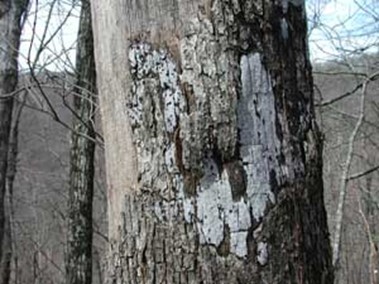Hypoxylon Canker on Shade Trees
Searcy, Ark. –
Hypoxylon Canker on Shade Trees
 Hypoxylon canker is a common infectious disease of oaks in Arkansas that can affect
several species of shade trees. Oak is the most susceptible, but sycamore and elm
are affected also.
Hypoxylon canker is a common infectious disease of oaks in Arkansas that can affect
several species of shade trees. Oak is the most susceptible, but sycamore and elm
are affected also.
This disease is caused predominantly by the fungi Hypoxylon tinctor and Hypoxylon atropunctatum. These fungi are not considered aggressive “killers” but instead take advantage of stressed or declining hardwood trees. Infected trees can be in various habitats, including recent or well-established residential areas and forest trees. Canker diseases can reduce tree growth, result in wind breakage, and weaken trees. These trees often become more susceptible to attack by secondary wood rotting fungi and insects.
Most damage occurs on stressed or injured trees. Trees stressed by environmental extremes and in danger of succumbing to Hypoxylon canker manifest symptoms typical of a declining tree.
These symptoms include:
- Yellow, brown leaves
- Small leaves and reduced twig growth
- Thinning canopy
- Dead limbs and branches
- Epicormic shoots (water sprouts) growing on trunks and large limbs
- Dieback of feeder roots
- White and stringy sapwood in the cankered area
Cankers are usually localized dead areas in the bark of the stems or twigs and are often recognized as a sunken, dead area. Sometimes, the healthy tissue immediately adjacent to the canker may thicken and appear higher than the normal surface of the tree. This callus formation around the diseased area helps limit disease expansion. However, under humid weather conditions, cankers can rapidly enlarge to lengths greater than 3 feet. The fungus usually kills the cambium and portions of the sapwood, creating the affected trunk or branch areas, potential for breakage. If cankers girdle the branch, the branch will die.
Stromata often become visible several months after the underlying tissues die and are the most obvious signs of the disease. Splashing water and wind spread the spores of the fungus to healthy trees.
What is the treatment for hypoxylon canker?
There is no cure for this disease, but stress avoidance is the most effective management strategy. The key ingredient to canker free trees is prevention. It is important to avoid tree wounds. A construction injury, herbicide damage and site related stresses (drought, etc.) contribute to disease onset.
Homeowners need to promote vigorous plant growth by correct fertilization and irrigation. Fertilization should be based on a recent soil test. If practical, selective pruning should be done to remove dead or damaged branches from the tree. This may help slow the advance of the fungus. Tree removal may become necessary if structural integrity becomes questionable, especially if the tree poses a threat to structures or people. Homeowners should monitor canopy status and overall vigor. In urban areas, tree health may need to be evaluated by a trained professional for the tree to be maintained properly.
For more information you can contact your local county extension service, you can also follow Sherri Sanders on Facebook @UADA.WhiteCountyAgriculture
###
By Sherri Sanders
County Extension Agent - Agriculture
U of A System Division of Agriculture
White County Extension Agent - Agriculture
U of A Division of Agriculture
Cooperative Extension Service
2400 Old Searcy Landing Road Searcy AR 72143
(501) 268-5394
ssanders@uada.edu